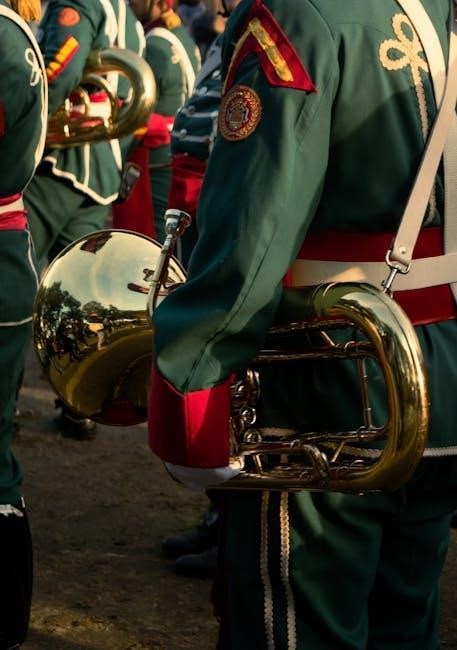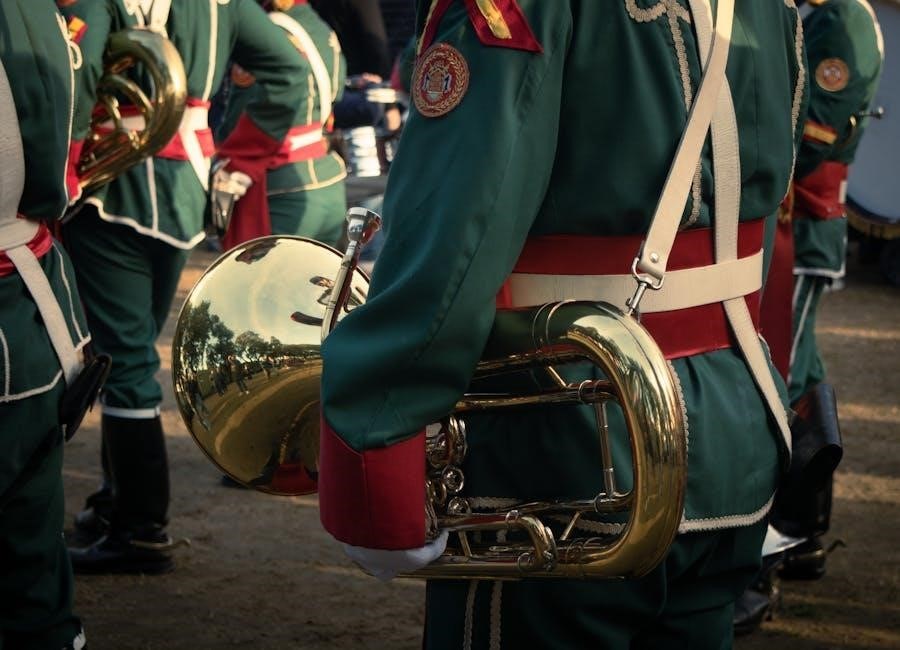Trumpet Studies PDFs provide comprehensive guides for musicians, offering classical and jazz techniques. These resources are accessible, adaptable, and vital for effective skill development across all levels.
1.1 Overview of Trumpet Study Materials
Trumpet study materials in PDF format encompass a wide range of exercises, techniques, and musical styles. Resources like Michael Droste’s Technical Studies and Kopprasch’s 60 Studies focus on building technical proficiency, while Arturo Sandoval’s works emphasize performance techniques. These materials often include scales, arpeggios, lip slurs, and etudes designed to improve musicianship. Jazz-oriented PDFs introduce improvisation and harmonic concepts, catering to diverse skill levels. Whether for classical or jazz trumpet, these study materials provide structured guidance, making them indispensable for both beginners and advanced players seeking to refine their skills.
1.2 Importance of PDF Resources for Trumpet Education
PDF resources for trumpet studies are invaluable for modern musicians, offering unparalleled accessibility and convenience. They provide comprehensive learning materials, from technical exercises to performance techniques, in a portable format. These resources are cost-effective, eliminating the need for physical books while ensuring high-quality content. Trumpet PDFs cater to all skill levels, whether beginners or advanced players, making them a versatile tool for education. Their availability online allows for easy access, enabling musicians to practice efficiently and enhance their skills without constraints. This accessibility fosters consistent improvement and supports the diverse needs of trumpet enthusiasts worldwide.

Popular Trumpet Study PDFs
Michael Droste’s Technical Studies, Arturo Sandoval’s Playing Techniques, and Kopprasch’s 60 Studies are renowned PDF resources, offering comprehensive exercises for trumpet mastery and performance excellence.
2.1 Michael Droste ⎻ Trumpet Technical Studies
Michael Droste’s Trumpet Technical Studies is a highly regarded resource, offering over 500 sequentially numbered exercises designed to enhance technical proficiency and musicality. This comprehensive guide covers a wide range of skills, from basic techniques to advanced methodologies, making it suitable for musicians of all levels. The PDF is freely available for download, providing accessibility to players worldwide. Droste’s studies focus on improving finger dexterity, breath control, and articulation, while also addressing musical phrasing and expression. It is a cornerstone for trumpet education, widely recommended by instructors and professionals alike for its structured and progressive approach to mastery.
2.2 Arturo Sandoval ⎻ Playing Techniques & Performance Studies
Arturo Sandoval’s Playing Techniques & Performance Studies is a seminal work for trumpet players, focusing on advanced techniques and performance mastery. This PDF resource provides in-depth insights into jazz improvisation, phrasing, and articulation, drawing from Sandoval’s legendary career. It includes exercises for developing speed, agility, and tone, along with practical advice for stage presence and musical interpretation. Sandoval’s method is renowned for its emphasis on both technical precision and emotional expression, making it a valuable tool for aspiring jazz trumpeters. The studies are structured to challenge players of all levels, offering a pathway to virtuosic performance.
2.3 Kopprasch ⸺ 60 Studies for Trumpet
Kopprasch’s 60 Studies for Trumpet is a foundational resource for trumpet players, focusing on technical development and musicality. These studies target range, tone, and dexterity, with progressively challenging exercises. Designed for intermediate to advanced players, they emphasize precise articulation, dynamic control, and phrasing. The PDF format allows easy access and practice, making it a staple in many trumpet curricula. Each study builds on the last, ensuring comprehensive technical mastery. Kopprasch’s work remains a cornerstone for trumpet education, offering versatility and depth for players seeking to refine their skills. Its structured approach ensures measurable progress, making it indispensable for dedicated musicians.

Benefits of Using Trumpet Study PDFs
Trumpet study PDFs offer unparalleled accessibility and convenience, providing cost-effective learning tools for musicians of all levels. They are free, versatile, and available in multiple formats for easy access.
3.1 Accessibility and Convenience
Trumpet study PDFs provide unmatched accessibility, allowing musicians to access resources anytime, anywhere. They are easily downloadable, eliminating the need for physical books. Students can print specific pages or use digital versions on tablets and smartphones, making practice sessions flexible. PDFs also enable bookmarking and highlighting, helping users organize their learning. This convenience is particularly beneficial for busy schedules, as musicians can review materials during commutes or breaks. The portability and ease of use make trumpet study PDFs an indispensable tool for modern learners, ensuring consistent progress and efficient practice routines. This accessibility fosters better engagement and overall musical development.
3.2 Cost-Effectiveness
Trumpet study PDFs are a cost-effective option for musicians seeking comprehensive learning materials. They often require a one-time purchase, offering long-term access to valuable exercises and techniques. Unlike physical books, PDFs eliminate the need for multiple purchases, as they can be easily shared or printed; Many resources are affordably priced or even free, making high-quality trumpet education accessible to a wider audience. This affordability ensures that musicians can invest in their growth without financial strain, while still gaining access to professional-level content; Cost-effective PDFs are a practical choice for students and professionals alike. This makes them an essential resource for trumpet education.
3.4 Versatility for Different Skill Levels
Trumpet study PDFs are designed to cater to musicians of all skill levels, from beginners to advanced players. These resources often include exercises tailored to specific abilities, ensuring that learners can progress at their own pace. Beginners benefit from foundational techniques, while intermediate and advanced players can explore complex etudes and solos. Many PDFs also offer adjustable tempos and customizable practice routines, allowing for personalized learning. This versatility makes trumpet study PDFs an invaluable tool for educators and students alike, providing a comprehensive and adaptable approach to trumpet education. They grow with the musician, offering challenges and growth opportunities at every stage.
Technical Aspects of Trumpet Studies
Trumpet studies focus on developing essential technical skills, including scales, arpeggios, lip slurs, and breath control. These exercises build precision, flexibility, and tone, forming a strong foundation for advanced techniques and musical expression. Mastering these elements is crucial for improving overall performance and versatility as a trumpeter.
4.1 Scales and Arpeggios
Scales and arpeggios are fundamental components of trumpet studies, essential for developing technical mastery. Major and minor scales, as well as chromatic scales, improve finger dexterity and pitch accuracy. Arpeggios, which break down chords into melodic patterns, enhance harmonic understanding and phrasing. Regular practice of these exercises strengthens embouchure and air support, allowing for smoother transitions between notes. Scales and arpeggios also serve as the building blocks for more complex musical passages, making them indispensable for both intermediate and advanced players. Incorporating these exercises into daily practice routines ensures consistent progress in technical proficiency and overall musicianship.
4.2 Lip Slurs and Flexibility Exercises
Lip slurs and flexibility exercises are crucial for developing a strong, agile embouchure and improving overall trumpet technique. These exercises focus on smooth transitions between notes without using the slide, enhancing precision and control. They also increase the player’s range and accuracy, particularly in the high and low registers. Regular practice of lip slurs and flexibility studies helps refine tone quality and ensures seamless navigation of complex melodies. These exercises are often included in trumpet study PDFs, providing structured routines for players to build and maintain technical mastery and musical expression.
4.3 Breath Control and Phrasing

Breath control and phrasing are essential for expressive trumpet playing, enabling players to produce consistent tone and dynamics. Proper breathing techniques enhance stamina, allowing for longer phrases and intricate passages. Phrasing involves articulation, dynamics, and timing, bringing musicality to performances. Trumpet study PDFs often include exercises that focus on breath control, such as long tones and sustained notes, and phrasing drills that emphasize nuance and expression. These studies help players develop a strong musical foundation, ensuring their performances are both technically proficient and emotionally engaging.
Jazz and Improvisation Studies
Jazz and improvisation studies in trumpet PDFs focus on developing spontaneity, creativity, and harmonic understanding. These resources often include chord progressions, scales, and rhythmic exercises to enhance improvisational skills.
5.1 Jazz Trumpet Techniques
Jazz trumpet techniques focus on developing phrasing, articulation, and tonal warmth. Players learn to navigate complex harmonies and rhythms, often studying transcriptions of legendary jazz trumpeters. Key elements include bending notes, growling, and advanced muting techniques. These methods enhance expressiveness and authenticity in jazz performances. PDF resources provide detailed etudes, solos, and exercises to master these skills, ensuring a strong foundation in jazz improvisation and interpretation. By Practicing these techniques, trumpeters can achieve a more nuanced and engaging sound, essential for excelling in jazz ensembles and solo settings.
5.2 Improvisation Exercises and Patterns
Improvisation exercises and patterns are essential for developing spontaneity and creativity in jazz trumpet playing. These exercises often focus on scales, arpeggios, and melodic patterns over chord progressions. Players practice variations like blues scales, modal interchange, and rhythmic displacement. PDF resources provide structured etudes and sequences to build fluency in improvisation. By mastering these patterns, trumpeters can craft cohesive solos and navigate complex harmonic landscapes with confidence. Regular practice of improvisation exercises sharpens musicality and enhances the ability to express emotions through spontaneous phrasing and melodic invention.
5.3 Application of Jazz Theory
The application of jazz theory in trumpet studies involves understanding chord progressions, scales, and modes to create coherent solos. Trumpet players learn to identify chord tones, guide tones, and extensions to navigate harmonic structures effectively. PDF resources often include exercises that apply jazz theory to real-world scenarios, such as improvising over ii-V-I progressions or modal interchange. By mastering these concepts, trumpeters can craft solos that align with harmonic frameworks while maintaining melodic and rhythmic creativity. This practical application of theory enhances improvisational skills and deepens the musician’s understanding of jazz language and structure.

Practice Routines Using PDF Studies
Structured practice routines using PDF studies enhance skill development through organized warm-ups, technical exercises, and etudes, ensuring consistent progress in tone, endurance, and musicality.
6.1 Daily Warm-Up Exercises
Daily warm-up exercises are essential for trumpet players to prepare their embouchure, fingers, and breath control. PDF studies often include routines like long tones, lip slurs, and scales to gradually increase agility and tone quality. These exercises should be played at a moderate tempo, focusing on smooth transitions and even pitch accuracy. Starting with simpler patterns and progressing to more complex ones helps build endurance and consistency. Allocating 15-30 minutes daily ensures proper preparation for more demanding pieces. Incorporating these exercises into a regular practice schedule fosters improvement in technical proficiency and overall musicianship, making them indispensable for players of all levels.
6.2 Long Tone Studies for Tone Development
Long tone studies are a cornerstone of trumpet practice, focusing on producing rich, resonant tones. These exercises, often found in trumpet study PDFs, involve playing sustained notes at a moderate tempo, emphasizing pitch accuracy and breath control. By starting with lower register notes and gradually ascending, players can develop evenness and consistency in tone quality. Long tones also improve embouchure strength and air support. Regular practice of these studies helps refine resonance and intonation, laying the foundation for advanced technical and lyrical playing. PDF resources typically include structured long tone exercises tailored for progressive development and mastery of tone production techniques.
6.3 Etudes for Technical Mastery
Etudes are meticulously structured exercises designed to enhance specific technical skills on the trumpet. These studies, often included in trumpet study PDFs, focus on challenging passages that refine articulation, finger dexterity, and range extension. By practicing etudes, players can improve precision and consistency in playing complex melodies and rhythms. Many etudes are composed to address common technical challenges, making them invaluable for advancing trumpeters. Regular etude practice, as outlined in PDF resources, helps build confidence and mastery of intricate musical passages, preparing players for demanding repertoire and performances. They are a key component of structured practice routines for achieving technical proficiency.
Advanced Trumpet Studies
Advanced trumpet studies focus on refining high-level techniques, exploring complex repertoire, and mastering nuanced performance skills. These studies prepare players for professional demands and sophisticated musical interpretations.
7.1 Orchestral Excerpts
Orchestral excerpts are essential for advanced trumpet studies, offering insights into the instrument’s role in large ensembles. These excerpts, often from symphonies, operas, and concertos, showcase complex passages, intricate harmonies, and dynamic contrasts. Works by composers like Mahler, Stravinsky, and Strauss are commonly studied. Trumpet players must master precise articulation, phrasing, and intonation to meet the demands of these pieces. PDF resources provide access to these excerpts, along with annotations and performance tips. Regular practice of orchestral excerpts enhances a player’s ability to adapt to varied musical styles and interpretative requirements, preparing them for professional auditions and performances.
7.2 Solo Repertoire
Solo repertoire for trumpet encompasses a wide range of compositions designed to showcase technical proficiency and musical expression. From classical concertos by Haydn and Hummel to modern works by composers like Arutunian and Jolivet, these pieces challenge players to master diverse styles and interpretations. PDFs of solo trumpet repertoire often include accompaniment scores, making them invaluable for practice and performance. Studying these works enhances articulation, phrasing, and overall musicianship. They also provide a platform for trumpeters to develop their unique voice and stage presence, preparing them for recitals and competitions. The variety ensures there’s something suitable for every skill level and musical interest.

7.3 Contemporary Techniques
Contemporary trumpet techniques expand the instrument’s capabilities, incorporating extended methods like multiphonics, microtones, and electronic effects. PDF resources often include exercises and etudes focused on these modern approaches, enabling players to explore new sonic possibilities. These studies emphasize experimental sounds and unconventional playing styles, pushing the boundaries of traditional trumpet performance. They are particularly valuable for musicians interested in avant-garde, experimental, or cross-genre music. By mastering these techniques, trumpeters can broaden their expressive range and adapt to diverse musical settings, from classical to electronic compositions. These innovative methods are essential for staying relevant in today’s evolving musical landscape.

Resources for Beginners
Beginner-friendly PDFs offer foundational lessons, including basic fingerings, simple melodies, and progressive exercises. These resources provide clear guidance for developing proper embouchure, breath control, and technique.
8.1 Basic Fingerings and Embouchure
Trumpet study PDFs for beginners often include detailed guides to basic fingerings and proper embouchure formation. These resources provide diagrams and exercises to help new players learn correct finger placement and develop a strong, consistent embouchure. Understanding fingerings ensures accurate note production, while proper embouchure promotes good breath control and tone quality. Many PDFs also offer step-by-step instructions for forming and strengthening the embouchure, making it easier for beginners to build a solid foundation. These materials are essential for mastering the fundamentals of trumpet playing and preventing bad habits from forming early on.
8.2 Simple Melodies and Songs
Trumpet study PDFs often include simple melodies and songs tailored for beginners, designed to make learning enjoyable and engaging. These pieces typically use familiar tunes, such as folk songs or children’s melodies, to help develop basic playing skills. By practicing these songs, students improve their tone production, rhythm, and breath control in a fun and motivating way. Many PDFs also provide accompaniment options or backing tracks, allowing learners to play along and build confidence. These materials are perfect for reinforcing basic techniques while introducing musicality and expression early in the learning process.

8.3 Progressive Learning Materials

Trumpet study PDFs often incorporate progressive learning materials that guide students through structured, step-by-step development. These resources typically include exercises, etudes, and songs that gradually increase in difficulty, ensuring a smooth transition from basic to advanced techniques. Many PDFs offer performance tips, practice schedules, and tracking tools to monitor progress. This approach helps build technical proficiency, musicality, and confidence. By aligning with the student’s skill level and learning pace, progressive materials make the learning process efficient and rewarding, ensuring a strong foundation for long-term improvement and enjoyment of trumpet playing.
Trumpet study PDFs are invaluable resources for musicians, offering comprehensive guidance, versatility, and accessibility to enhance skills and mastery. They provide structured learning for all levels, ensuring progress and enjoyment in trumpet playing.
9.1 Summary of Trumpet Study PDFs
Trumpet study PDFs offer a comprehensive collection of exercises, etudes, and techniques tailored for players of all skill levels. These resources cover foundational skills like scales, arpeggios, and lip slurs, while also addressing advanced concepts such as jazz improvisation and orchestral excerpts. Popular materials include works by Kopprasch, Michael Droste, and Arturo Sandoval, ensuring versatility and depth. The accessibility and cost-effectiveness of these PDFs make high-quality education attainable for musicians worldwide. They serve as invaluable tools for building technical mastery, improving tone, and fostering artistic expression, catering to both classical and contemporary trumpet playing.

9.2 Final Tips for Effective Practice
To maximize progress with trumpet study PDFs, establish a consistent practice routine and set specific goals for each session. Begin with warm-ups to develop proper embouchure and breath control. Use a metronome to improve timing and precision. Practice challenging passages slowly, gradually increasing speed as mastery grows. Record your sessions to track progress and identify areas for improvement. Incorporate long tones for tone development and lip slurs for flexibility. Stay relaxed, maintain good posture, and take regular breaks to avoid fatigue. Consistency and patience are key to achieving technical mastery and artistic expression.